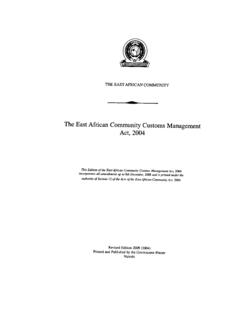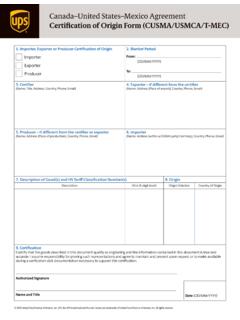Transcription of ASEAN AND CHINA FREE TRADE AGREEMENT (ACFTA)
1 1 ASEAN AND CHINA FREETRADE AGREEMENT (ACFTA) The AGREEMENT on TRADE in Goods (TIG) under ACFTAwas signed on November 29,2004 andentered into force for most ASEAN members and CHINA on July 1, 2005 andJuly 20, 2005, respectively. On December 8, 2006, theParties signed the SecondProtocol to Amend the TIG Framework AGREEMENT , incorporating Vietnam. On October16, 2009 Cambodia finally ratified ACFTA marking the full implementation of the TIGA greement for all ASEAN Members and the AEM-MOFCOM Consultations in August 2009, ASEAN and Chinaagreedtoamend the Operational Certification Procedures (OCP)
2 After several years amendments include arevised definition of issuingauthority,theacceptance of third-partyinvoicing,the utilization of back-to -backcertificates oforiginForm E (called a movement certificate), andtheacceptance of country verification visitsunder certain revisions are scheduled to take effect on June 1, Parties are also undertaking a substantive review of theTIGA greement in order tobring it on par with other ASEAN TIG Agreements with Australia and New Zealand, India,Japan, and Korea.
3 The Parties finalized a WorkProgram for the TIG Reviewin June2009 and have alreadybegun tackling key areas including: (i) updating tariff reductionschedules based upon HS 2007/AHTN with clearly identifiable Normal Track (NT) 1 and2, Sensitive List (SL), Highly Sensitive List (HSL) and Early Harvest Program (EHP)categories (currentlythe AGREEMENT utilizes HS 2002)as well as the second batch ofproduct specific rules of origin (PSR); (ii) reviewing further liberalization of sensitiveproducts under the FTA; (iii) monitoring Form E utilization and proposing actions forimprovement.
4 And (iv) addressing non-tariff areas remain underdiscussion and are expected to be settled in Reduction and Elimination ModalityOn January 1, 2004, ASEAN and Chinaimplemented an Early Harvest Program (EHP)for early tariff reduction and elimination for selected products,coveringmost of theproducts from HS Chapters1 through 8, andapproximately 130specific manufacturedproducts (not under HS Chapters 84, 85 or 87). On November 29, 2004, the two sidessigned the TIG AGREEMENT , which formally entered into force in July the TIG AGREEMENT , CHINA and ASEAN -6 agreed to eliminate tariffs on 90% ofproducts by 2010, with flexibility for certain products until January 1, 2012.
5 Cambodia,Laos, Myanmar and Vietnam agreed to eliminate tariffs on 90% of products by 2015,with flexibility for certain products until January 1, 2018. The remaining 10% of productsare deemed as TIGA greement covers a total of 7,000 tariff lines. Thetariff reduction and elimination modality is comprised of several tracks: EHP, NormalTrack 1 (NT1), NT2, and Sensitive Track, which is divided into the Sensitive List (SL)and the Highly Sensitive List (HSL).Normal Track(NT1 and NT2) and ChinaThere is no physical list of items for products falling under NT1.
6 If a product is not in NT2,SL or HSL, then it automatically falls under NT1 and tariffs will be reduced to zero2percent by January 1, 2010. NT2 includes products accorded flexibility in NT1 and arelisted in Annex 1 of Appendix 1 of the TIG AGREEMENT . The deadline for tariff eliminationis January 1, following table details the total number of NT2 tariff lines at the6-digit level under HS Chapters 84, 85and 87for ASEAN -6 and *THAILANDSINGAPORE**CHINAC hapter 841450110-11 Chapter 850814192-26 Chapter 871410410-12* Philippines tariff concessions were published on January 12, 2006.
7 **Allproducts from Singaporehavezeropercenttariffrates,exce pt twotypesof , Laos,Myanmar, VietnamThere is no physical list of items for products falling under NT1 for Cambodia, Laos andMyanmar. If a product is not in NT2, SL or HSL, then it automatically falls under NT1 andtariffs will be reduced to zero percent by January 1, 2015. NT2 includes productsaccorded flexibility in NT1 and are listed in Annex 1 of Appendix 1 of the TIG deadline for tariff elimination is January 1, 2018.
8 Vietnam agreed to eliminate 45%of NT1 tariffs by January 1, 2013 and follows the same modality as the abovementionedcountries for NT2 following table details the total number of NT2 tarifflines under HS Chapters 84, 85and 87for Cambodia, Laos, Myanmar, and *CHINAC hapter 84270137211 Chapter 85110539126 Chapter 87131812*Vietnam s datawas amended on December 8, 2006under the Protocol to Amendthe TIG AGREEMENT . Vietnam s lines are at the 8-digit TrackProducts in theSensitive Track are divided into two lists: (i) the Sensitive List (SL);and(ii) theHighly Sensitive List (HSL).
9 These lists include sensitive products that ASEANand CHINA seekto protect from immediate tariff concession. For CHINA , these productsincluderice, natural rubber, palm oil, chemical products, digital televisions, andboardand paper products; for ASEAN , they includerubberandplastic products, ceramic ware,textiles and garments, steelproducts, household electricalappliances, automobiles, andmotorcycles. Products in the Sensitive Track are subject to twoceilings based on tariff3lines or total import value.
10 ASEAN -6 may include no more than 400 tariff lines at the 6-digit level, or no more than 10% of total import value based on 2001 TRADE countries may include no more than 500 tariff lines at the 6-digit level or no morethan 10% of total import value based on 2001 TRADE List (SL) and ChinaProducts under the SL are listed in Appendix 1 of Annex 2 of the TIG AGREEMENT . TheParties agree to reduce the applied MFN tariff rates of tariff lines placed in theirrespective SL to 20% not later than January 1, tariff rates will besubsequently reduced tobetween 0 to 5% by January 1, 2018.









